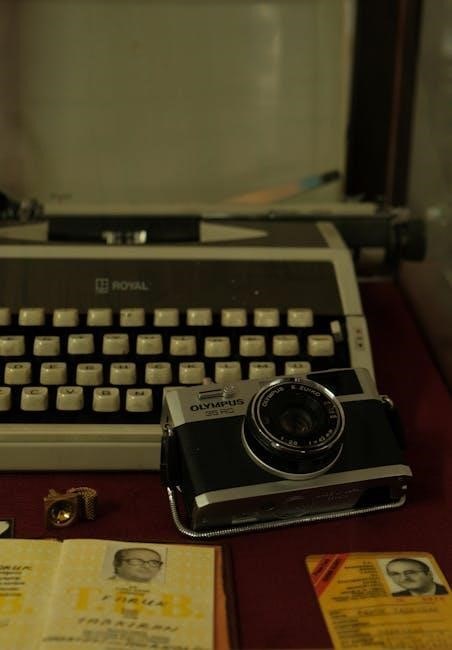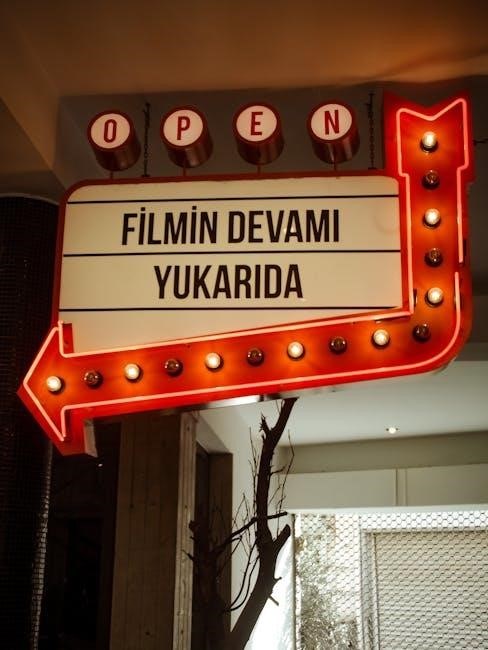
corrigan timothy a short guide to writing about film
Timothy Corrigan’s A Short Guide to Writing About Film is a practical guide to film analysis, emphasizing critical thinking and precise writing skills, essential for film studies.
Overview of the Book and Its Importance in Film Studies
A Short Guide to Writing About Film by Timothy Corrigan serves as a foundational text for film studies, offering practical advice on analyzing and writing about cinema. Its concise and accessible approach makes it an invaluable resource for students and scholars alike; The book bridges film theory and practice, providing tools to critically engage with films while fostering clear and effective writing. Widely recommended, it has become a cornerstone in film education, emphasizing the importance of understanding both visual and narrative elements. Corrigan’s work continues to inspire critical thinking and creative analysis in the study of film.
Timothy Corrigan’s Background and Contributions to Cinema Studies
Timothy Corrigan is a prominent scholar and professor of English and Cinema Studies at the University of Pennsylvania. His work focuses on film theory, criticism, and pedagogy, making significant contributions to the field of cinema studies. Corrigan’s A Short Guide to Writing About Film has become a cornerstone for students and educators, offering practical insights into film analysis and writing. His expertise has shaped how film is studied and written about, emphasizing critical thinking and clear expression. Corrigan’s contributions continue to influence contemporary film scholarship and education.

Key Elements of Film Analysis
Film analysis involves examining mise-en-scène, editing, sound, and narrative structure to understand visual and storytelling components, enabling critical interpretation of cinematic works.
Understanding Mise-en-Scène: Setting, Lighting, and Composition
Mise-en-scène is a fundamental concept in film analysis, referring to the arrangement of everything within a frame. It includes setting, which establishes the story’s world, lighting, which creates mood and highlights elements, and composition, which guides viewer focus. Analyzing these visual elements reveals how they contribute to the film’s narrative, themes, and emotional impact, offering insights into the director’s vision and storytelling techniques. This approach emphasizes the importance of visual storytelling in cinematic expression.
The Role of Editing in Shaping Film Narrative
Editing is a crucial element in filmmaking, as it shapes the narrative structure and pacing of a film. By selecting and arranging shots, editors control the flow of information, evoke emotions, and guide the audience’s focus. Techniques like cross-cutting, montage, and continuity editing create rhythm and emphasize key themes; Corrigan highlights how editing influences the viewer’s perception of time, space, and character development, making it essential for conveying the director’s vision and enhancing storytelling effectiveness.
Sound and Music: Enhancing Mood and Storytelling
Sound and music are vital in shaping the emotional and narrative depth of a film. Diegetic sounds, like dialogue and ambient noise, and non-diegetic elements, such as scores and sound effects, work together to create mood and guide the audience’s emotional response. Corrigan emphasizes how sound design and music can manipulate tension, evoke empathy, or establish thematic resonance. By analyzing these auditory elements, viewers gain deeper insight into the film’s narrative and emotional layers, enhancing their understanding of the director’s intent and the story’s impact.

Writing Strategies for Film Criticism
Corrigan’s guide emphasizes critical thinking and clear writing, teaching students to analyze films effectively, develop strong arguments, and structure essays with clarity and precision.
Developing a Thesis: Focusing on Central Arguments
Corrigan emphasizes the importance of crafting a clear and specific thesis statement to guide film criticism. A strong thesis should reflect a unique perspective, focusing on key themes, motifs, or directorial choices. It should be supported by evidence from the film, such as dialogue, visuals, or narrative structure. Corrigan advises students to avoid overly broad statements and instead narrow their arguments to a manageable scope. This approach ensures that the essay remains coherent and persuasive, with each paragraph contributing to the central claim. His guidance helps writers transform observations into compelling analyses.
Corrigan stresses the importance of a clear structure in film criticism. The introduction should present a thesis and provide context, while body paragraphs should focus on specific film elements like mise-en-scène or editing, supported by evidence. Each paragraph should build on the thesis, ensuring coherence. The conclusion should summarize the analysis and reinforce the central argument, avoiding new ideas. This structured approach ensures clarity and persuasiveness, guiding readers through the critique effectively.
Using Evidence: Clips, Quotes, and Scene Analysis
Corrigan emphasizes the importance of using specific evidence in film essays to support arguments. Clips and quotes from films serve as primary sources, grounding analysis in concrete examples. Scene analysis allows for detailed exploration of visual and auditory elements, demonstrating how they contribute to the film’s themes. By integrating these elements effectively, writers can build persuasive critiques that align closely with their thesis, ensuring a robust and evidence-based argument that engages readers and enhances understanding of the film’s artistic and narrative strategies.

Exploring Film Genres andStyles
Corrigan’s guide explores how film genres and styles shape storytelling. By analyzing genre conventions and auteur theories, writers gain deeper insights into films’ artistic and cultural significance.
Identifying Genre Conventions and Their Impact on Analysis
Corrigan’s guide highlights the importance of recognizing genre conventions, such as narrative patterns and visual styles, to deepen film analysis. These conventions influence audience expectations and cultural context, shaping how films communicate themes. By identifying genre elements, writers can critically evaluate a film’s adherence to or deviation from traditions, revealing its unique artistic and cultural significance. This approach enhances analytical precision and enriches the understanding of cinematic storytelling.

Analyzing Auteur Theory: Director’s Unique Style
Corrigan’s guide emphasizes the significance of auteur theory in film analysis, which focuses on a director’s distinctive style and recurring themes. By examining visual motifs, narrative patterns, and thematic preoccupations, writers can uncover a director’s unique vision. This approach allows for a deeper understanding of how filmmakers imprint their identity on their work, influencing the interpretation of their films. Auteur theory, as discussed, provides a framework for analyzing consistency and evolution in a director’s oeuvre, enriching critical perspectives on cinematic artistry.
Historical and Cultural Contexts in Film
Historical and cultural contexts shape a film’s themes, representation, and narrative, offering insights into societal norms and cultural values of its time, enriching analytical perspectives.
Understanding the Historical Background of a Film
Understanding the historical context of a film involves analyzing the time period, social movements, and cultural norms that influenced its creation. This background shapes the plot, characters, and themes, reflecting the era’s values and challenges. Films often mirror historical events or societal changes, offering insights into the past. By studying this context, viewers can better interpret the film’s message, symbolism, and relevance. Corrigan emphasizes that historical awareness enhances critical analysis, allowing deeper connections to the film’s artistic and cultural significance.
Cultural Influences on Film Themes and Representation
Cultural influences significantly shape film themes and representation, reflecting the traditions, values, and identities of specific groups. Films often embody cultural narratives, symbols, and perspectives, influencing how stories are told and characters are portrayed. These influences can also impact audience interpretations, as cultural contexts shape reception. Corrigan highlights the importance of analyzing cultural elements to uncover deeper meanings in films, emphasizing how they enrich storytelling and representation, making films a powerful medium for cultural expression and dialogue.

Visual and Narrative Structures
Visual and narrative structures in film work together to convey themes and engage audiences, enhancing storytelling effectively through their interplay, as explored in Corrigan’s guide.
Breaking Down Narrative Techniques in Film
Narrative techniques in film shape storytelling through plot structure, character development, and pacing. Corrigan emphasizes analyzing how these elements convey themes and engage audiences. Techniques like flashbacks, voiceovers, and dialogue reveal character motivations and advance the plot. Visual elements, such as mise-en-scène and editing, further support narrative depth. By examining specific scenes, viewers can uncover how filmmakers guide audience interpretation. This approach bridges theory and practice, offering practical strategies for critical analysis in film writing, as outlined in Corrigan’s guide to enhance understanding and appreciation of cinematic storytelling.
Visual Motifs and Their Significance
Visual motifs are recurring visual elements that carry thematic or symbolic meaning in a film. Corrigan highlights their importance in reinforcing narrative themes and character development. Through repeated imagery, such as specific colors, shapes, or objects, filmmakers convey deeper meanings. Analyzing these motifs helps viewers decode the director’s intent and understand how visual patterns contribute to storytelling. By identifying and interpreting these elements, writers can uncover layers of meaning, enriching their critical analysis and appreciation of cinematic artistry, as explored in Corrigan’s guide to film writing.

Critical Approaches to Film Study
Critical approaches to film study include feminist, Marxist, and psychoanalytic perspectives, offering frameworks for analyzing themes, power dynamics, and psychological elements in cinematic narratives.
Feminist, Marxist, and Psychoanalytic Perspectives
Feminist, Marxist, and psychoanalytic perspectives offer distinct lenses for film analysis; Feminist theory examines gender roles, representation, and power dynamics. Marxist approaches focus on class, economic structures, and societal inequalities. Psychoanalytic frameworks explore unconscious motivations, desires, and psychological conflicts. These critical methods enable deeper interpretations of themes, character behaviors, and cultural contexts in films. Corrigan’s guide highlights how these approaches can uncover underlying meanings and broaden understanding of cinematic narratives, encouraging nuanced and multifaceted critiques.
Ethical Considerations in Film Criticism
Ethical considerations in film criticism involve balancing personal opinions with objective analysis, ensuring respect for diverse perspectives, and avoiding spoilers. Critics must consider cultural and social contexts, representing identities fairly and avoiding harmful stereotypes. Corrigan’s guide emphasizes the importance of ethical responsibility, urging critics to evaluate films thoughtfully while remaining mindful of their impact on creators and audiences. These principles foster a respectful and inclusive approach to film analysis, promoting meaningful dialogue and understanding.
Corrigan’s guide provides essential tools for film analysis, emphasizing critical thinking and precise writing. It equips readers to approach film criticism with depth and clarity, fostering meaningful engagement with cinema.
Summarizing Key Insights from Corrigan’s Guide

Corrigan’s guide emphasizes the importance of critical thinking and structured analysis in film criticism. It highlights key elements like mise-en-scène, editing, and sound, while providing practical strategies for organizing essays and developing strong arguments. By focusing on both visual and narrative structures, the book offers a comprehensive approach to understanding and writing about film. Corrigan’s insights enable readers to engage deeply with cinema, fostering a balance between technical analysis and personal interpretation in their critiques.
Applying These Strategies to Your Own Film Writing
Corrigan’s strategies empower writers to craft insightful film analyses by applying critical thinking and structured approaches. By focusing on mise-en-scène, editing, and sound, readers can develop evidence-based arguments. The guide encourages balancing technical analysis with personal interpretation, fostering engaging and analytical writing. These practical tools help transform ideas into compelling critiques, making Corrigan’s guide an essential resource for developing film writing skills and producing thoughtful, well-supported essays.